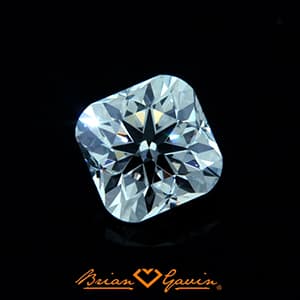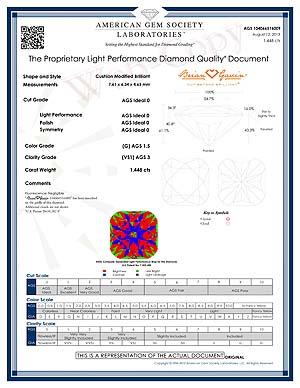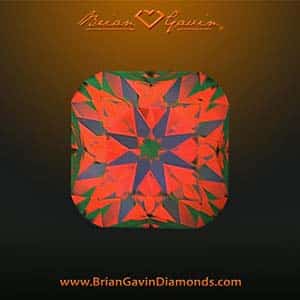It's been a long time since a new diamond shape has taken my breath away. However, I have to admit that I find the Brian Gavin Signature Cushion cut diamond completely captivating.
I've had the opportunity to review several of these diamonds in-person over the past few months. The volume of light return and sparkle factor continue to blow my mind.
Take this 1.448 carat, G-color, VS-1 clarity, Brian Gavin Signature Cushion cut diamond for instance. Just look at how beautiful it appears in the video on the diamond details page. Imagine how beautiful it will be in real life instead of a video optimized at lower resolution for the web.
Ideal Cushion Cut Diamond Proportions:
From what I've seen, the Brian Gavin Signature cut diamond rivals the sparkle factor of a round brilliant. This should not be surprising given the fact that Brian Gavin is one of the foremost authorities on light performance.
As such, the new line of Brian Gavin Signature Cushion cut diamonds have an overall cut grade of AGS Ideal-0. The diamonds are graded on the American Ge Society Light Performance grading platform.
That means that the light performance is verified using the Angular Spectrum Evaluation Tool (ASET). The multi-colored ASET map appears on the Diamond Quality Document DQD) for the 1.448 carat, G-color, VS-1 clarity, Brian Gavin Signature Cushion cut diamond on the left.
Do you see all that red color? That indicates that this diamond is very bright and gathering light from all the right places! You know that this diamond is going to be stunning by that fact alone.
The proportions of this diamond are amazing! As a matter of fact, the proportions of the Brian Gavin Signature Cushion very similar to an ideal cut round. With that in mind, this diamond has a total depth of 61.1% and a 54.7% table diameter.
The crown angle of 34.3 degrees s offset by a pavilion angle of 40.8 degrees. The girdle edge is thin to slightly thick and faceted so that it has a brighter finish.
Using ASET to Judge Light Performance in Cushion Cut Diamonds:
As stated previously, the proportions of Brian Gavin Signature Cushion cut diamonds are similar to a round brilliant ideal cut diamond. That is why the volume of light return is so much higher than it is for other versions of cushion modified cut diamonds.
Of course, you don’t have to take my word for it. Just look at all the red and green that is visible in the ASET Scope image shown below.
The color red on an ASET image represents the brightest light which is being reflected by a diamond, and the color green represents the second brightest light being reflected.
The color blue by the way is used to show the contrast created by the relationship between our heads and the light. However, in this particular instance, it is the dark color of the camera lens, reflecting off of the eight pavilion main facets.
This type of intensity is produced by combining zero ideal cut proportions with precise alignment of the facets. In addition, the higher degree of consistency of facet shape per facet section produces a higher volume of light return.
The sparkle factor is also more vivid and intense. Refer to this article for more information on what the different colors of an ASET Scope image represent.
Another reason that Brian Gavin Cushion Cut Diamonds are brighter and more vivid is because the facet structure is also similar to a round brilliant cut. As a matter of fact, it even has 57 facets just like a round brilliant cut diamond. In addition, the facet structure is symmetrical, so the light reflects evenly throughout the diamond.
Why I Chose This Particular BGD Cushion Cut Diamond:
One of the reasons why I selected this particular BGD Signature Cushion to write about today is because it falls just short of the 1.50 carat mark. That means that it represents a great value because you get the look of a 1.50 carat diamond without paying the premium that occurs between the 1.49 - 1.50 carat marks.
As you might imagine, diamonds weighing between 1.40 - 1.49 carats are very popular for this reason. At the same time, they are a fairly rare occurrence because it makes more sense for the cutters to produce a diamond that weighs more than 1.50 carats.
This means that Brian Gavin had a choice to make and he decided to focus on light performance instead of retention of carat weight. Suffice to say that most diamond cutters are most likely to focus on profits rather than sparkle factor.
At the same time, I like the balance that G-color and VS-1 clarity provide. This diamond is going to face-up bright and white and be clean to the naked eye. As a matter of fact, it will be difficult for most people to see the inclusions using 10x magnification.
The primary inclusions indicated on the plotting diagram are just a few small crystals and clouds. The latter of which is nothing more than a small cluster of pinpoint size diamond crystals. These types of inclusions are just tiny diamonds that were trapped within a larger diamond crystal as it formed.



